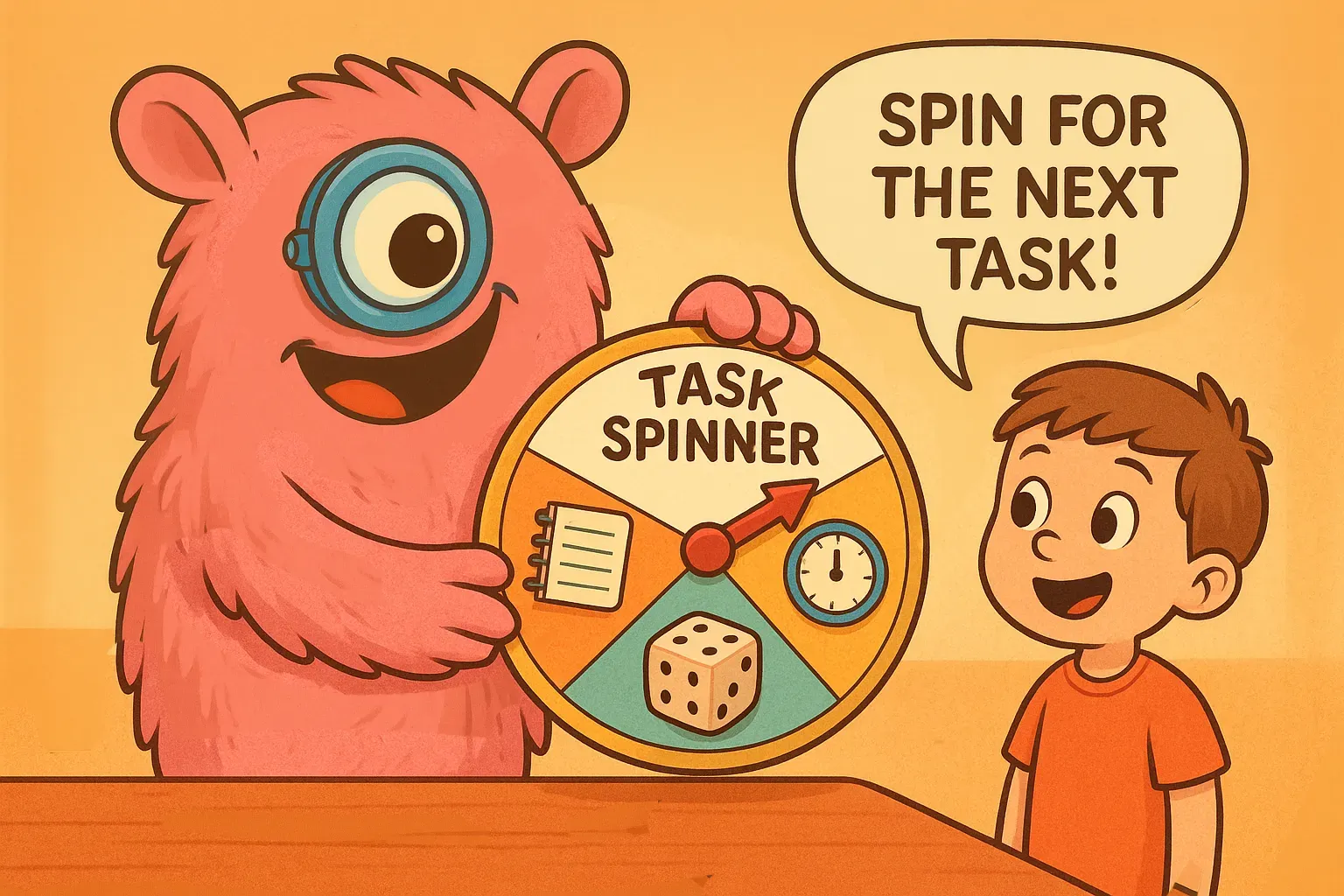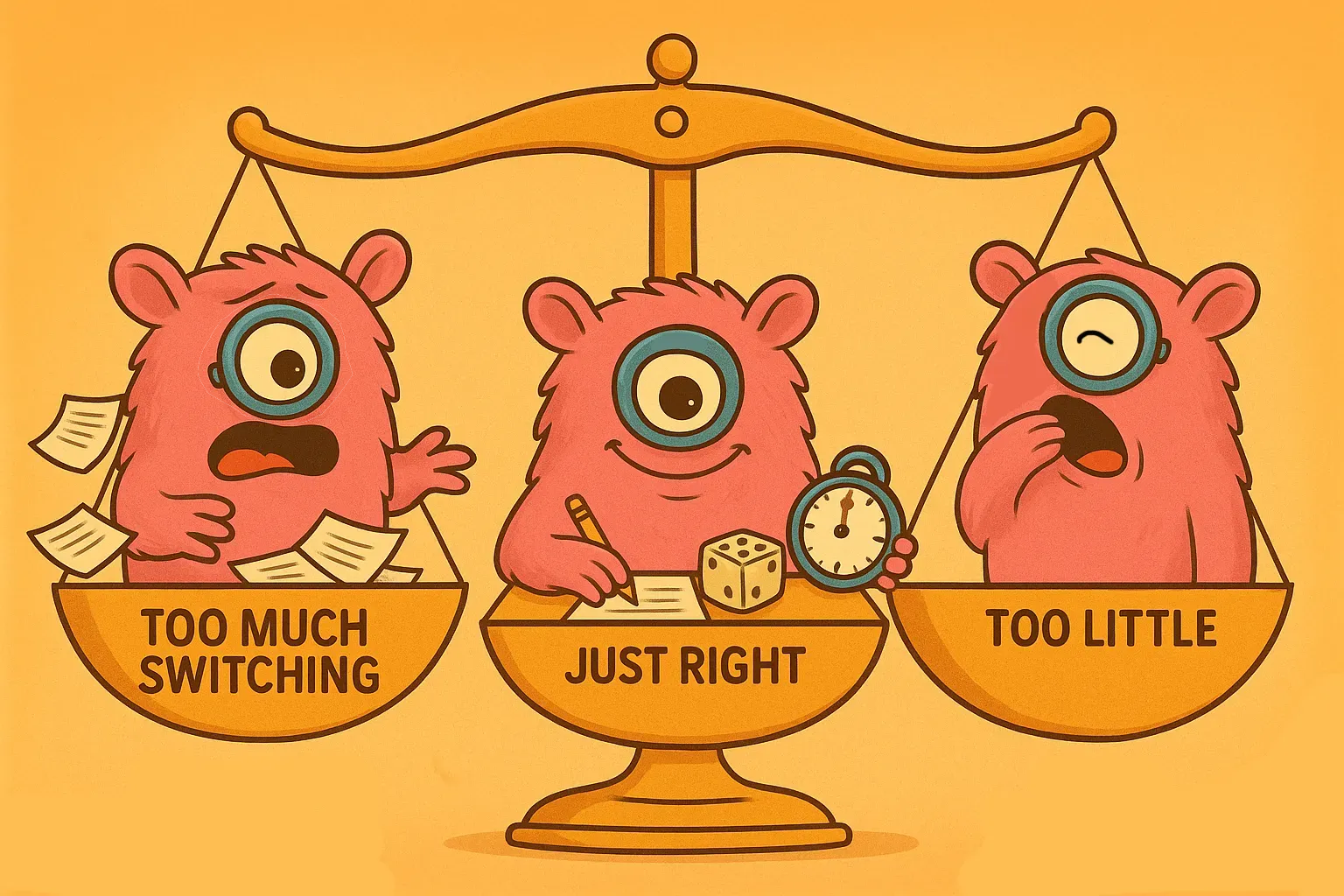Task Switching in Math: Helping ADHD Kids Jump Between Concepts
TL;DR: Harnessing task switching – the intentional shifting between different math tasks or concepts – can help children with ADHD stay engaged and learn more effectively. ADHD brains often crave novelty and stimulation, making it hard to focus on one thing for long. By interweaving varied math activities, incorporating short breaks, and using strategies to support cognitive flexibility, parents and teachers can turn ADHD students’ urge to jump between ideas into a learning advantage, rather than a distraction.
For many kids with ADHD, sitting still and slogging through a single math topic for an extended period can feel nearly impossible. It’s not just an attention problem – ADHD affects math learning through working memory deficits and executive function challenges that make multi-step problems and prolonged focus difficult. Yet these same “wandering mind” tendencies can be leveraged positively...
Children with ADHD tend to have brains wired for seeking novelty and stimulation. In fact, neurological studies show that novelty acts like a reward for the ADHD brain, triggering dopamine release and drawing their interest. One study noted that heightened novelty seeking is characteristic of ADHD – the brain treats new stimuli as intrinsically rewarding. This helps explain why an ADHD student who can’t sit through a long worksheet might light up with enthusiasm for a new game or unexpected challenge. Their motivation and focus often spike when something fresh or surprising is introduced.
On the flip side, repetitive or prolonged tasks can lead to rapid drops in attention. Many parents notice that an ADHD child may be able to focus on math for a few minutes, but then the “mental fuel” runs out. Clinically, paying attention requires extra effort for those with ADHD, leading to quicker fatigue. It’s been observed that dopamine (a neurotransmitter tied to reward and focus) can dip after a short period of boring work, causing the child’s brain to seek something more interesting. Rather than fighting this neurochemical reality, we can work with it by adding variety into math learning sessions. By switching tasks before attention flatlines, we effectively “reset” the child’s focus with new stimulation, keeping their engagement tank topped up.
However, it’s important to structure this variety. Without guidance, a child might bounce aimlessly between tasks (or off-task distractions). The goal of educational task switching is to strategically alternate between different math activities or problem types in a way that maintains novelty without causing confusion. For example, a student might do five minutes of arithmetic drills, then solve a quick word problem, then spend a few minutes on a math game or a visual puzzle. Each shift gives the brain a fresh start. In essence, we’re acknowledging the ADHD brain’s need for frequent new stimuli and using planned task switches to channel that need toward productive learning.
The Challenge: Cognitive Flexibility and “Set Shifting” in ADHD
Ironically, while ADHD kids crave frequent changes, they also often struggle with the executive function skill known as cognitive flexibility – the brain’s ability to switch gears smoothly. Research in child psychology has found that children with ADHD show substantially larger “switch costs” when changing tasks compared to non-ADHD peers. In other words, when asked to rapidly shift from one mental task to another in laboratory settings, they tend to take a bigger performance hit (slower or less accurate responses) than other children. This difficulty with sudden transitions is part of ADHD’s executive functioning profile. It’s not that they can’t ever switch – it’s that their brains need a bit more help to do so efficiently.
Encouragingly, this is an area where support and tools can make a big difference. Medication is one well-known support: stimulant medications like methylphenidate can significantly improve cognitive flexibility. In fact, the study above noted that on ADHD medication, kids’ task-switching performance became equivalent to that of control children. But medication aside, we can also use behavioral strategies to assist with transitions. Visual or auditory cues, clear routines, and having a plan for how to shift tasks can all reduce the mental “friction” when it’s time to move to the next activity.
It’s also worth noting that ADHD-related deficits in working memory play a role here. Working memory is the ability to hold information in mind and manipulate it, and it’s crucial for multi-step math problems. Studies show that children with ADHD often have weaker working memory, which in turn affects their math skills . This means that insisting an ADHD student stick to one complex problem for too long can overload their mental scratchpad – they might forget what they were doing or lose track of steps. By breaking work into shorter segments (and switching to a different kind of task before returning), we prevent overloading their working memory. Essentially, brief resets or concept changes can act as a pressure release valve, giving their brain a chance to refresh.
The key takeaway is that ADHD learners benefit from both novelty and structure. They need variety to stay engaged, but they also need support to handle transitions. That’s why an intentional task-switching approach – sometimes called building cognitive flexibility or “flexible thinking” – is so valuable. It acknowledges the paradox of ADHD: these kids may jump between ideas on their own (often to the detriment of sustained work), but with guidance, jumping between concepts can be transformed into an educational strategy rather than a liability.
Benefits of Task Switching Training and Interleaved Practice in Math

Aside from sustaining attention, mixing up math tasks has some powerful learning benefits backed by research.
Cognitive scientists have found that practicing different types of problems in one session – known as interleaved practice – can enhance long-term retention and understanding. In one study, students who learned with interleaved problem sets (switching between topics) remembered the material better on a test two weeks later, compared to those who learned each concept in a separate block. The interleaving strategy forced them to constantly retrieve and apply different techniques, which improved their mastery over time (even though their immediate performance during practice might have felt harder). For ADHD students, who might already prefer bouncing between ideas, interleaving plays to their strengths by providing continual novelty and reinforcing learning through spaced repetition.
Interleaving in math could look like this: instead of doing 20 addition problems in a row, then 20 subtraction, then 20 geometry, an interleaved set might rotate through 5 of each type repeatedly. The child has to stay on their toes, because each new problem might require a different method. This prevents the autopilot effect (where they do the same kind of problem without thinking) and keeps engagement higher. It’s effectively academic task switching built into the practice. For an ADHD learner, this variety can be intrinsically more engaging, and as studies suggest, it may improve their retention of concepts as well.
Another benefit of structured task switching is that it can train the brain’s executive functions over time. There is promising evidence that practicing task-switching itself can strengthen cognitive flexibility. In a controlled trial, researchers had children with ADHD practice a “task-switching training” regimen – essentially exercising the skill of rapidly shifting mental sets. The result: those kids showed a significant reduction in their switching costs and improvements in executive control (including better inhibition and working memory) compared to when they did only single-task training. In other words, practicing flexible thinking made them more flexible thinkers . While that study used computer-based tasks, the principle can apply to learning at home or in class. By regularly incorporating mini “switches” in math activities, we give ADHD students a safe space to exercise and gradually improve their ability to transition smoothly.
Lastly, don’t overlook the role of movement and physical breaks as part of task switching. Physical activity has been shown to boost attention and executive function in children with ADHD. Simply standing up and doing a quick movement game or stretch can reset a child’s focus. In fact, a review of interventions found that regular physical activity improves cognitive flexibility and inhibitory control in kids with ADHD. That’s why alternating a sit-down math task with an active one (like a math fact hopscotch or a brief exercise break) isn’t just “letting off steam” – it’s actively enhancing the brain’s readiness to re-engage. Movement spikes dopamine and blood flow in the brain, which can help an ADHD student come back to the next math problem refreshed and ready to think clearly.
Strategies to Help ADHD Kids “Switch” Without Losing Track
Introducing task switching into math practice requires a thoughtful approach. Here are several evidence-backed strategies and practical tips to make it work:
- Use Time Chunking and Micro-Sessions: Break math work into short, clearly defined chunks. For example, set a timer for 5-10 minutes per task. Let the child know that “we’ll work on these fraction problems for 5 minutes, then switch to a new activity.” Knowing a break or change is coming can increase their willingness to focus now, and a ticking timer can provide a gentle external cue for transition. Many ADHD specialists recommend frequent short breaks – one guideline is about 10 minutes of work per grade level for homework, split into smaller sprints. A fourth-grader might do 2 sets of 5-minute math exercises with a 2-minute movement break in between, rather than a single 10-minute stretch straight through.
- Alternate Task Types (Interleave Concepts): Plan the practice session to intermix different kinds of math problems. For instance, create a worksheet or set of problems that rotates through addition, geometry, and word problems in sequence. By alternating concepts (even within the same overall topic), you prevent boredom and force the brain to reboot attention for each new problem type. Research supports that switching between concepts improves long-term learning (even if it feels a bit harder in the moment). Over time, your child may also become more comfortable with switching strategies on the fly, a skill that can help in complex problem-solving.
- Incorporate Movement Breaks and Brain Boosters: Physical movement can serve as a natural “reset” button between academic tasks. Encourage your child to get up and do jumping jacks, dance for a minute, or even solve a math fact by throwing a ball back and forth. One strategy is the “Pomodoro” technique adapted for kids – e.g., 8 minutes of math, 2 minutes of active break, repeat. These active breaks aren’t just play; they actually improve subsequent focus and have been found to increase attention and inhibitory control in children with ADHD. Some teachers even use quick classroom exercises or yoga stretches to help ADHD students transition between subjects. The same can be done at home during homework time.
- Provide Clear Transition Cues: Since ADHD kids can struggle with the mechanics of switching tasks, use external cues to signal when and how to switch. This could be a visual timer turning red when time’s up, a fun sound (like a chime or bell) at the end of an activity, or a simple verbal prompt: “Time to switch – let’s close the workbook and grab our shapes for geometry!” Making the switch a structured routine (rather than an abrupt stop) helps the child mentally prepare. Some parents create a colorful chart or use colored index cards to indicate what comes next – for example, a red card means it’s time to change to a new task. Consistent cues and routines build a sense of security around transitions.
- Keep a “Thread” Between Switches (Mini-Recap): One risk of task switching is the child might completely drop what they were doing and not return to unfinished tasks. To prevent this, use brief recaps and written notes. When pausing one activity, have the student quickly say or jot down what their last step was or what needs to be done when they come back. For example: “We’ll stop this problem here. Can you mark which step we were on? Great – write yourself a note: next, multiply by 2.” This way, when you eventually cycle back, they have a hook to recall their place. Teaching them to use placeholders – like circling a problem number they didn’t finish – also signals that “we’ll return later.” It’s a balancing act: we want to switch before frustration or fatigue hits, but also teach them to resume tasks and follow through to completion over multiple short bursts.
- Gamify Task Switching: You can make the whole process of alternating tasks into a game itself. For instance, create a “task treasure hunt” where each completed task or solved problem earns a puzzle piece or clue for the next activity. Or use a reward system: each time the child switches to a new task without protest and stays on it for the set time, they get a token or a star. At the end of the study session, tokens can be traded for a small treat or privilege. Another idea is the “Win & Spin” deck (inspired by some ADHD educators): have a stack of cards with fun mini-activities (e.g., “30-second dance party” or “draw a quick comic of a math problem”). When the child finishes a task, they draw a card and do the silly activity before switching to the next math task. This keeps novelty high and makes transitions something to look forward to, rather than a pain.
- Leverage Strengths and Interests Across Concepts: Try to connect different math tasks with a common theme or the child’s special interests, so switching feels natural. For example, if your child loves dinosaurs, do a short dinosaur-themed word problem, then a dinosaur counting game, then maybe graph some favorite dinosaurs by size. The context switches (word problem to game to graphing) but the theme keeps them emotionally invested. Similarly, you can harness an ADHD student’s strengths like creativity or visual-spatial skills. If they excel at drawing, let them sketch a scenario for a math problem as one “task,” then compute as the next. This not only keeps things engaging but also validates that jumping between modes (visual, numerical, story) can be an asset, not a flaw.
Building Flexibility for the Long Run
When consistently applied, these task-switching strategies do more than get today’s homework done – they help ADHD kids develop greater cognitive flexibility for the future. In math, flexible thinking is crucial. Students who can approach problems from multiple angles and switch strategies when needed tend to be more successful. Our aim is to guide ADHD learners from “jumping around at random” to deliberate flexible thinking in math .
Initially, the adult structures the switches (much like training wheels), but over time, the child begins to internalize this rhythm. They start to recognize when they’re hitting a focus wall and may initiate a strategy change or ask for a break appropriately, rather than melting down or tuning out.
It’s also important to keep an eye on the balance between switching and completing. Some tasks will need revisiting to finish, and that teaches responsibility and persistence. Celebrate progress in the executive skills too: praise your child not just for getting answers right, but for smoothly moving to the next activity, or for coming back and finishing something they paused earlier. These are victories in self-regulation and flexibility. Over weeks and months, you may notice improvements in how your child handles transitions in other contexts as well – such as moving from playtime to dinnertime with less difficulty – because they’ve been practicing cognitive shifting in a low-stress way during math time.
In summary, task switching in math is a bit of a Goldilocks art: switch tasks too chaotically or too often and the child might lose depth; stick with one thing too long and you lose them to boredom or frustration. With thoughtful intervals, cues, and a mix of activities, you can find the “just right” amount of switching that keeps your ADHD learner engaged and progressing. Remember, the ultimate goal is helping them learn effectively and joyfully. If jumping between concepts is what it takes to light up that joy and curiosity for math, then by all means, let’s jump – with a safety net in place!
Frequently Asked Questions
How often should I switch tasks for my ADHD child during math homework?

It depends on your child’s age and focus capacity, but a good rule of thumb is to switch or break before you see signs of fading focus . For younger kids (age 6–9), this might be every 5–10 minutes. Older children might handle 10–15 minutes on one task if it’s engaging. Keep an eye on your child: if they start fidgeting more, staring off, or getting frustrated, that’s a cue to switch things up. You can even ask them – some kids can feel their attention slipping and will appreciate a change. Using a timer can help make this more predictable. For example, try a routine of 8 minutes work, 2 minutes break, and adjust as needed. Over time, you’ll discover your child’s optimal focus interval. Remember, the goal is to end a task on a positive note, not when the child is already burnt out.
Won’t switching tasks so often prevent my child from learning to stick with anything?
When done thoughtfully, task switching will improve their ability to stick with things in the long run. We’re not abandoning tasks entirely; we’re spacing them out. Think of it like cross-training the brain. By returning to tasks after short breaks, your child actually practices persistence in a more sustainable way. They learn that “taking a break or doing something else for a bit” doesn’t mean “I quit” – it means “I’ll come back recharged.” In fact, many kids find it easier to finish something after they’ve had a breather or a change of pace. Over time, as their focus and stamina grow, you can gradually lengthen certain tasks. But even adults rarely work straight through without any shifts in attention! We check our emails, stand up for coffee, etc. The structured switching your ADHD child is learning is a scaffold towards developing their own self-regulation. Eventually, they won’t need every activity to be 5 minutes long, but they will have the self-awareness to take breaks and re-focus as needed.
My child hyperfocuses on things they enjoy – should I interrupt if they suddenly focus deeply on a math game or topic?
Hyperfocus – the flipside of ADHD in which a child can become intensely absorbed in something – can be a great asset when it happens with a productive task like math. If your child is safely and meaningfully engaged, and not neglecting something urgent, you don’t always need to break the hyperfocus. Ride the wave of their interest! That said, keep an eye on their mental fatigue and physical needs. If they’ve been laser-focused for a long time, a gentle interruption for a bathroom break or a snack might be warranted. You can also use hyperfocus sessions as a reward: for instance, “After we do these two short tasks, you can spend 15 minutes on that math puzzle app you love.” In general, the purpose of task switching is to keep engagement high – if engagement is already sky-high naturally, there’s less immediate need to switch. Just help them learn to manage it (like saving work, or knowing when to pause for other priorities). It’s all about balance and using their unique ADHD brain in a positive way.
How do I explain this approach to my child’s teacher?
Many teachers are familiar with the idea of giving ADHD students frequent breaks or varied tasks as accommodations. You can share what works for your child and even provide examples. For instance, mention that your child does better when assignments are broken into chunks, or that they focus well for about 10 minutes before needing a reset. You might suggest an arrangement like having a “menu” of math tasks at their desk so they can switch between a couple of activity options if they get stuck (with teacher guidance). Emphasize that you’re not trying to let your child avoid work – rather, this approach helps them produce better quality work by leveraging their strengths. You could even share some of the research: e.g., how mixing problem types improves learning, or how physical activity boosts ADHD kids’ concentration. Collaborate with the teacher to ensure that essential tasks do get completed, while also giving your child the flexibility to learn in a way that suits their brain. Most teachers will be glad to know what motivates your child and keeps them engaged, because that’s a win-win for classroom learning.
References
- Sethi, A., et al. (2018). A neurocomputational account of reward and novelty processing and effects of psychostimulants in ADHD. Brain, 141(5), 1545–1557.
- Cepeda, N. J., et al. (2000). Task switching and attention deficit hyperactivity disorder. J. Abnorm. Child Psychol., 28(3), 213–226.
- Kray, J., et al. (2012). Can task-switching training enhance executive control functioning in children with ADHD? Front. Hum. Neurosci., 5:180.
- Park, J., Varma, K., & Varma, S. (2023). The role of executive function abilities in interleaved vs. blocked learning of science concepts. Front. Psychol., 14:1199682.
- Martín-Rodríguez, A., et al. (2023). The Role of Physical Activity in ADHD Management: Diagnostic, Digital and Non-Digital Interventions, and Lifespan Considerations. Children, 12(3), 338.
- Gaye, F., et al. (2024). Working Memory and Math Skills in Children with and without ADHD. Neuropsychology, 38(1), 1–16.

